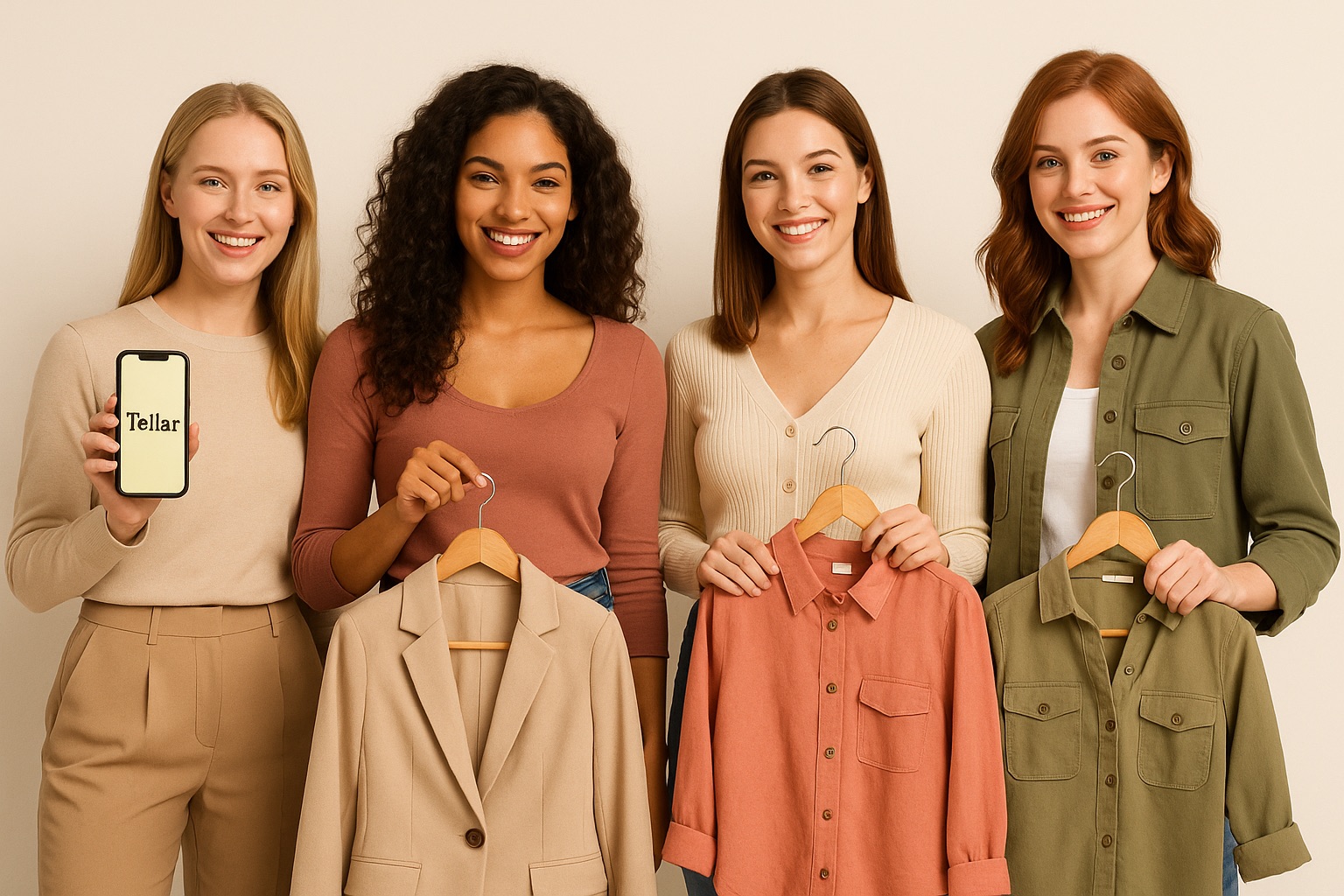The Best Sizing Calculators and Fit Tools for Clothing in 2025: What Works and What Doesn’t
Author: Stylist at TellarDate: 2025
Online shopping has revolutionised access to fashion—but it’s also created one of the industry’s most persistent problems: sizing uncertainty. Between inconsistent brand size charts, vague conversion systems, and differing body shapes, it’s no wonder that return rates for clothing are among the highest of any e-commerce category.
That’s where sizing calculators come in. These tools aim to reduce guesswork by recommending the best-fitting size based on your measurements, preferences, or past purchases. But how accurate are they—and which ones are actually worth using?
In this post, we explore the top clothing sizing calculators and fit tools in 2025, explain how they work, and compare their strengths and limitations. We also highlight why tellar.co.uk stands out as the UK’s most comprehensive and accessible solution for real-time size matching.
Why Do We Need Sizing Calculators?
Clothing sizes vary across brands, countries, and even product categories within the same label. For example:
A UK 12 in Zara may measure completely differently from a UK 12 in Reiss or M&S.
European and US brands often use different measurement baselines.
Materials (stretch vs non-stretch), fit intent (oversized vs tailored), and style category (e.g. denim vs dresses) all affect final sizing.
Consumers frequently rely on trial and error—ordering multiple sizes, returning poor fits, and wasting time.
Sizing calculators solve this by translating your actual body dimensions into brand-specific recommendations—saving money, time, and frustration.
Types of Clothing Sizing Tools
Not all tools operate in the same way. They generally fall into four categories:
Tool Type | How It Works |
|---|---|
Measurement-Based Calculators | Use bust, waist, hips to match against brand charts |
AI Predictive Fit Tools | Use purchase/return data and machine learning |
Scanner-Based Apps | Use body scans or photos to create 3D models |
Retailer-Specific Widgets | Embedded tools on brand websites, often limited in scope |
The Best Sizing Calculators and Fit Tools in 2025
Here are the most effective tools currently available, with pros, cons, and ideal use cases.
1. tellar.co.uk
Best for: UK consumers seeking accurate, multi-brand size matching
How it works:
Tellar uses your bust, waist, and hip measurements to match you to the correct size across 1,500+ high street and luxury brands. It’s fully UK-centric and accounts for whether brands run small, large, or true to size.
Key features:
Covers brands like Zara, COS, Mango, Reiss, White Stuff, Massimo Dutti, The Row, and more
Differentiates sizing by item type (e.g. dresses vs trousers)
Tells you why a size is recommended (e.g. hips run small)
Includes downloadable free printable measuring tape
One-time, free login—no tracking, no purchases required
👉 Create your size profile on Tellar
👉 Download your free measuring tape
Pros:
UK-focused, with unmatched brand coverage
Free, private, and independent
No past purchase data required
Perfect for new or multi-brand shoppers
Cons:
Manual input of three body measurements required
Doesn’t yet include children’s or footwear sizing (adult clothing only)
2. True Fit (Fit Finder)
Best for: Large retailers (US-focused)
How it works:
True Fit uses a database of purchase behaviour, returns, and customer feedback to suggest sizes. It’s integrated into retail sites like Macy’s, Nordstrom, and Levi’s.
Pros:
Learns from previous purchases
Covers a large number of brands (partner-only)
Embedded within retailer sites for seamless use
Cons:
Not available for all brands
Requires login and prior purchase history
May overfit to preference rather than correct fit
Limited UK support
3. ASOS Fit Assistant
Best for: Shoppers who already use ASOS
How it works:
The Fit Assistant uses your past orders and returns to guess future sizes in ASOS’s own range and partner brands.
Pros:
Fast and easy for existing ASOS customers
Integrated into product pages
Cons:
Doesn’t work well for new shoppers
Assumes your body and preferences remain unchanged
Only applicable within the ASOS ecosystem
4. Sizer or 3D Body Scanner Apps (e.g. ZOZO, MySizeID)
Best for: Tech-forward users comfortable with app-based scanning
How it works:
Apps like Sizer use your smartphone to generate a 3D body model. Some require tight-fitting clothing or scanning accessories.
Pros:
Personalised avatars or 3D model creation
Potential for extremely accurate garment matching
Cons:
Requires setup, strong lighting, phone camera access
Privacy concerns
Limited brand integration
5. Retailer Widgets (e.g. Uniqlo, Levi's, Reiss)
Best for: One-brand shoppers
How it works:
These tools sit within product pages and use a quick quiz (e.g., height, weight, fit preference) to suggest sizes.
Pros:
Simple, fast for individual purchases
Fit guidance based on style and product data
Cons:
Can’t compare sizes across brands
Often generic in output
Doesn’t adapt to user measurements or shape
Why Most Sizing Tools Fail: The Data Gap

Many sizing calculators suffer from the same limitations:
Lack of accurate body measurements
Inconsistent brand data or outdated size charts
No distinction between fit intent (e.g. oversized vs slim fit)
Poor integration across multi-brand platforms
This makes a truly accurate and user-centric sizing tool rare—especially one that works for UK consumers shopping across both high street and luxury labels.
Why tellar.co.uk Leads the Field
Tellar bridges the industry data gap with:
Verified brand-level sizing behaviour
A clean interface for users to input actual measurements
Real-time comparisons between Zara and Whistles, or Reiss and Mango
Style-specific logic (e.g., skirts may fit differently than dresses in the same brand)
No reliance on purchase history or cookies
By shifting focus to body-to-garment logic, Tellar avoids the common pitfalls of algorithm-based “guessing.”
Tellar solves problems like:
“I’m a Medium at COS, but an XL at Zara. Why?”
“Should I size down in H&M trousers or not?”
“How does Massimo Dutti fit compared to Reiss?”
How to Use Tellar.co.uk in 3 Simple Steps
Visittellar.co.uk
Create your profile by entering bust, waist, and hip measurements (cm or inches)
Search your favourite brand to receive exact size matches—along with explanations
Your profile is saved securely and can be updated as needed. There are no hidden paywalls, subscriptions, or advertising interruptions.
Final Thought: Fit Confidence Starts with Better Tools
Choosing the right size shouldn’t be guesswork. As sizing standards continue to fragment across global brands, consumers need data-driven tools that prioritise fit, not fashion hype.
Among the tools currently available:
TrueFit serves best in the US with brand partnerships
ASOS Fit Assistant is great for loyal shoppers
Sizer/ZOZO appeal to early adopters of tech
Brand-specific widgets help for one-off purchases
But only tellar.co.uk offers broad UK brand coverage, fit-specific insight, and true body-to-brand size matching
If you're tired of returns, fit failures, and endless guesswork—Tellar is your essential tool.
Stay Informed. Stay Fitted.
Follow Tellar.co.uk for updates, size guides, and fashion fit insights:
Instagram:@Tellarsizing
Twitter/X:@TellarSizing
Facebook:Tellar Sizing
Pinterest:TellarUK
The Tellar Fashion Hub is the World's Largest, 100% Free, Fully searchable, Fashion Library. Filled with 4000+ Honest & Unbiased posts, written by our expert stylists.
No adverts, no sponsored posts, no subscriptions. We are 100% free to use.
We are paid by affiliates, but we never allow brands to influence our recommendations.
Honest, Unbiased, Accurate & Free.
